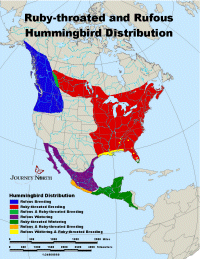| Please
Report Your Sightings! |
Celebrate the story of Sweet Pea in this week's slideshow. Find out about banding little hummers and what we can learn from this technique. How will the Gulf of Mexico oil spill affect the migration? And share your thoughts about the little migrants that reach the northern-most part of the breeding grounds.
Today's Report Includes:
- Highlights, Maps, and Questions
- Journal: Long Distance Rubythroats
- Nest Sightings and Patience
- Migration and the Gulf of Mexico Oil Spill
- Assessment: What Have We Learned?
- Year-end Evaluation: Please Share Your Thoughts

Photo:
Rachel Powless
What's strange about this female rubythroat?
Explore
Highlights:
Spotters
continue to report their first sightings of hummingbirds as we move into
the first week of June. In the northern reaches of the ruby-throated hummer's
range the end of a cold, wet May has brought the reward of a first of
the year sighting to many. Our hummingbird expert reports this year has
been different with fewer sightings than average.
Fewer
Hummers Arriving at Feeders in Arkansas
Marie wrote to Journey North, "We
are in rural North Central Arkansas and normally have 30 to 40 Hummingbirds
feeding at our home. This year, we have 2. Nothing has changed in our
area to affect nesting, so we can't understand why they have not arrived
in the numbers they usually do."
Lanny Chambers has been seeing the same pattern in Missouri. "I don't understand this either," he said. "Arkansas had a snow storm in early April that may have affected the migration. Wait and see how the season develops," was Lanny's response.
Northern
Sightings Continue |
 |
May
21: Clive, Manitoba
Saw 1 male at feeder—poor guy. Zero C at night and
rainy May 21-23. Turned warmer by May 24. During week of May 24 - 28 a
pair were seem regularly at the feeders. Today snow and have seen one
at feeder for a second. I'm trying to replace syrup with room temperature
syrup about twice a day. Hope it help!
May
30: Springfield, Virginia
First year with feeders. I am so excited to actually see one.
May
29: Linwood, New Jersey
Saturday 5/29/10 at 1:09pm, a hummingbird came to the
feeder in my backyard. It was very late this year for the hummingbirds
to arrive. Last year they were earlier Why?
May
28: Sterling Heights, Michigan
Went
out back to dump feeders and noted about 50 ft. away My first male Ruby
Throat (we've been ready since April 15) He stayed about 4 minutes and
did feed from the small feeder in the wild tree. Oh Joy!
 Distribution Map |
||
| Rufous
|
Ruby-throated
|
|
| Handouts: Today's Hummingbird Map Questions | ||
In the
last month, lots of ruby-throated hummingbirds have been spotted north
of the Canadian border. When do you think those birds left their winter
grounds? How did they travel? Think about these possibilities:
1. The "northern" rubythroats left earlier than the ones that
breed farther south (closer to wintering grounds).
2. They left later than the others, arriving in Canada when northern
flowers bloomed and insects hatched.
3. They left at the same time as the rest of the hummers. They kept heading north as others settled down farther south.
On this
hummingbird journal
page, write down which of these options you think is most likely.
Explain why you made your choice. What clues from this year helped you
out?
There is no one right answer that applies to every hummer! Next
week we'll tell you what some bird experts think.
Now that mating and nesting season are upon us take some time to watch the bird activity in your area. Bird behavior changes when the adult must build a nest and care for young chicks.
Often your patient observations will be rewarded. This hummingbird nest is barely the size of a quarter.
Although we do not know what wide ranging effects the giant oil spill in the Gulf of Mexico will have on migrating birds, our expert Lanny Chambers pitched in to answer a couple questions weighing heavily on the hearts and minds of Journey North participants.
"Will the oil spill affect the fall hummingbird migration to their wintering grounds? Will the birds smell the oil and avoid the trip over the Gulf of Mexico?"
Lanny wrote, "Like all North American birds except turkey vultures, hummingbirds have almost no sense of smell. I can't imagine the oil would make any difference at all."
Fall
Migration: Do Ruby-throated Hummers Cross the Gulf in Fall?
"While
there's plenty of evidence that some Ruby-throated cross the Gulf in the
spring, there's no such evidence for a fall crossing. A couple of years
ago, I banded a young male here in St. Louis in late summer, and it was
recaptured by another bander in east Texas two weeks later. In fact, I
wouldn't be surprised if we learn some day that our Midwestern hummers
use the land route in both directions."
| Teachers: The migration is wrapping up in the next few weeks! What
Have We Learned? |
Will you take a few minutes to complete our Year-end Evaluation? With your help, we can we document Journey North's reach, impact and value. We need comments like yours to keep the program going and growing.
-
Year-end Evaluation: Please Share Your Thoughts

The NextHummingbird Migration Update Will Be Posted on June 9, 2010.






